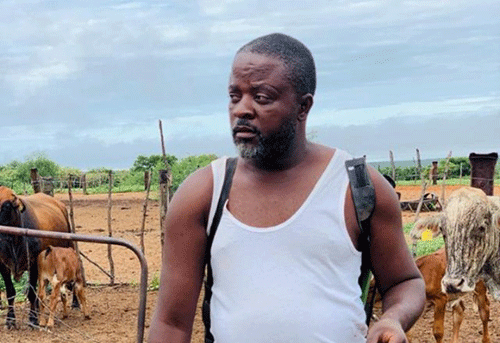For years, Gerhard Mbakoo Tjijeura and others in the Eiseb area of the Omaheke region have been battling many farming challenges such as predators, water shortages and bad access roads. But it is their battle against the infamous poisonous plant, the gifblaar, from Afrikaans, or Otjikurioma as it is known among locals, that far outweighs the rest.
Gifblaar, known by its scientific name, Dichapetalum cymosum, is a poisonous plant that usually grows in acidic soil in sandy, flat areas. The poison leaf can cause serious livestock losses if precautionary measures are not taken.
The plant is one of the biggest causes of livestock losses because it flourishes when little else is available. It sprouts in late winter, around September, and is usually the only green plant at the time.
Many have shied away from the grazing rich areas of Eiseb, Gam and others where the gifblaar reigns supreme for fear of losing their livestock.
But a few, like Tjijeura, have prevailed and still eke out a living from farming in this hostile environment and he is determined to stay on, in spite of the obvious dangers. The reason; the area is too good to give up. Instead, he and others in the area have found ways to live with the gifblaar and other potent plants.
"I have been a farmer all my life as I was born into farming. That is reality. I started buying livestock after I got employed in 2006. My choices were mainly Brahman and Simmentaler at the time, which later meant I had a good selection of Simbra breed of cattle in the end,” he said.
His break, however, only came in 2009 when he ventured on his own and moved from his traditional base of Ekuenye in the Otjozondjupa region to his current farming location in the Eiseb area.
Tjijeura is not a believer in many traditional methods that have been used to save livestock that have eaten poisonous plants. These methods include sprinkling grinded charcoal into the drinking water of the animals, or pouring some diesel into the drinking trough.
He instead believed that animals built resistance against such poisonous plants, and should be allowed to do so as many other remedies hardly save them.
"It may not be scientifically proven or so, but we believe that cattle develop resistance to poisonous plants over time. If you take a horse from here to Antarctica or colder countries, such a horse would adjust its body in such a way that it eventually is accustomed to the conditions there. So also do cattle in these areas," said Tjijeura.
He, however, does turn to some natural remedies, including a ‹no sacrifice› stance on animal health. This would include giving the right vitamin supplements, licks and fodder to the livestock to boost their immunity against possible poisonous plant infections.
Managing livestock against the poisonous plants is however no easy feat, Tjijeura said. For instance, it is imperative to constantly keep an eye on the livestock, especially when they return from grazing.
One cow may move at a bit slower pace than others, or it may make a walk-stop routine on its way to the water trough. That is a clear sign that it has consumed the poisonous plant, and remedial measures should be immediately enforced, Tjijeura said.
"This is the time where you isolate it and prevent it from drinking water as it would surely die if it does so. Keep monitoring it and eventually, the toxins will leave the body and it will live," he said.
Fortunately for the farmers, the gifblaar is a seasonal plant as it does wither and eventually dies in the dry period. Also, livestock do not necessarily eat the gifblaar, but accidentally consume it with grass as it grows close to such grass.
Tjijeura is determined to keep experimenting with different methods to keep the gifblaar at bay. But he knows that many before him have tried and are yet to produce definite results. Nonetheless, life will go on as he continues expanding his farming enterprise amidst the challenges.
"The bottom line here is that you have to inspect your livestock and be hands-on to make sure they are not taken by the gifblaar. Anything less than that would be suicidal,” warns Tjijeura.
-tjatindi@gmail.com


